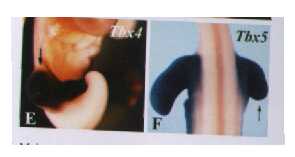
Through a process of pattern formation, the initial body plans are laid out in broad strokes, upon which subsequent factors act to refine to form secondary fields. One of these secondary fields, the developing limb bud, is defined and patterned through the action of a number of signals and organizating centers.
The vertebrate limb is composed of two types of embryonic tissue, the lateral plate mesoderm, which form buds at specific regions, and somitic mesoderm cells, that migrate from the lateral edge of the somites. The lateral mesoderm serves as a precursor to subsequent skeleton mesenchyme along with tendons and cartilage. All limb muscle is derived from the migratory somitic cells, while the nerves and vasculature are derived from extra-limb tissue.
The limb bud, all ready composed of mesoderm and somitic cells, become surrounded by ectodermal tissue, where consequently the Apical Ectodermal Ridge (AER) is formed; that is at the dorsal/ventral border (see gene interactions). The AER runs the length of the anterior/posterior axis and subsequently begins to emanate factors. The AER derived signals lead to the formation of an organizer (Gibson-Brown et al 1998) as well as cartilage blastomers, precursors to skeletal limb components. Of these precursor cells, the proximal limb cells, while under the influence of the AER and other signals such as the Hox code, undergo condensation and differention. The AER meanwhile inhibits the differentiation of other regions, thereby promoting limb outgrowth. Thus, the first long bone of the arm or leg develops first, followed by the radius and ulna, and lastly by the digits.

Figure 1. AER removal does not effect the expression of Tbx4 (E), or Tbx5 (F), (Gibson-Brown 1998). The arrows in each panel notes the continued expression of the T-box gene in the trucated limb.
Henceforth, the AER is a narrow band of cells derived from the convergence of dorsal and ventral ectoderm, made possible by the expression of Engrailed-1 in ventral ectoderm and Radical Fringe in dorsal ectoderm.
As a consequence, the signals involved in AER formation and dorsal patterning (en-1, r-Fng, Wnt, and Lmx-1), along with signals emenating from the AER itself, such as Hoxb-8 and FGF's, induce the formation of an organizer, the Zone of Polarizing Activity (ZPA). The ZPA is thought to be involved in causing proliferation of posterior limb bud mesenchyme and limb identity along the anterior/posterior axis. Another factor, Sonic hedgehog was found to interact with the ZPA and is essential for polarizing activity, which in turn is responsible for proper A/P and proximal/distal limb patterning.
To summerize, Johnson and Tabin (1997) put it best when they describe secondary field development occuring in four stages: "1. Cells within each field are defined; 2. positional information is provided by signalling centers after establishment; 3. positional info is put out on a cell by cell basis; 4. based upon already ecoded positional info, cells differentiate accordingly upon subjection to additional cues."
Go to
The T-Box genes The Hox genes Discussions Glossary of Terms References
Go to the

Top